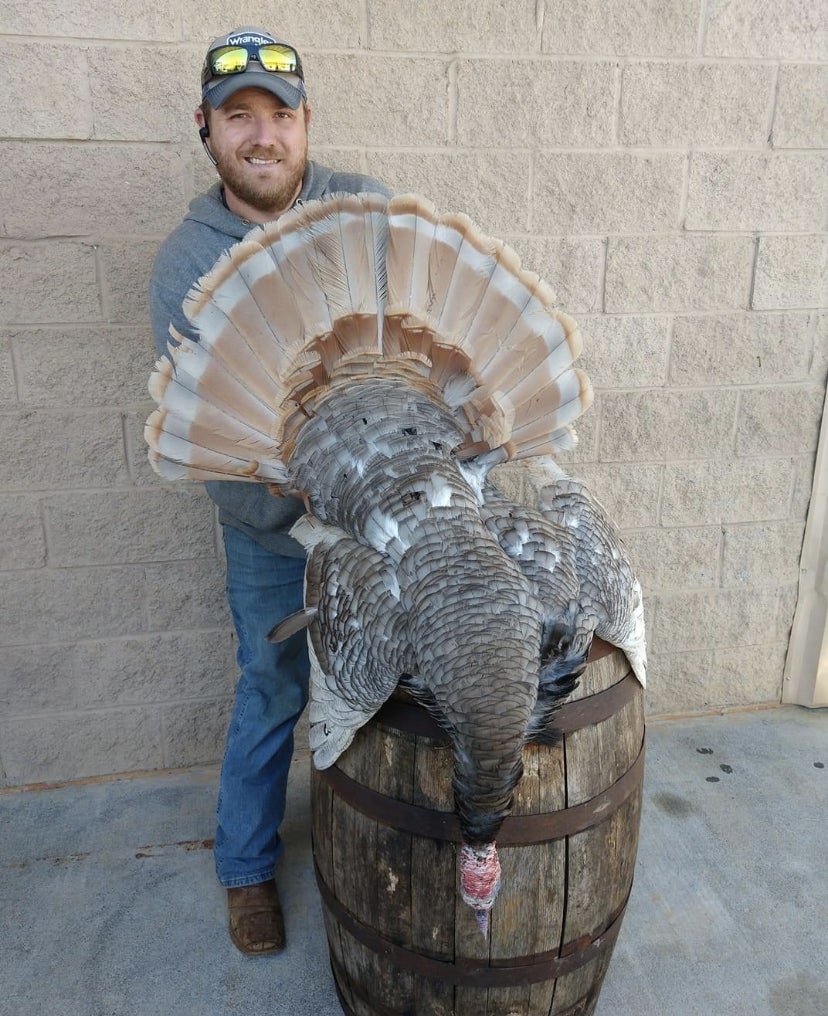Georgia Man Slays Rare Smoke Phase Gobbler Minutes After Shooting His First-Ever Turkey
Russ Chastain 04.23.20

This turkey is cool and the story about it is unique, but I have to admit that after hunting hard for ten days to bring home exactly zero turkeys, learning about a rare bird being pretty much shot in someone’s yard is tough to swallow. But sharing it with you folks is part of the job, so here it is.
It happened in Chatsworth, Murray County, Georgia, where a guy named Derek Pritchett reportedly killed his first two gobblers on his family farm within minutes of one another — and one of them was a rare “smoke phase” gobbler whose plumage has a faded or washed-out appearance.
On April 3, a regular-looking black gobbler showed up on the farm. Derek, who said he was really just having a good time with his grandfather, decided to put out hen and gobbler decoys in the front pasture.
“A week later I was working on my front porch, and we had to leave and go get some pry bars. We left, and in my dad’s front pasture were two birds strutting, not even 50 yards from his pole barn,” said Derek.
Amazingly, the two gobblers were strutting around the decoys and looked like they were fixing to fight. They were so focused on each other that they didn’t pay any attention to Derek and the Ranger he was riding in.
“They were fixing to lock up and fight,” said Derek. “They had attacked the decoys, they bent the metal rods.”
Derek, who says he was really interested in the delicious meat that wild turkey would put on his table, got into the pole barn and grabbed a shotgun. He was able to sneak up to the gobblers as they remained focused on the decoys and each other.
“I pulled the trigger on the black one, I figured it was the more dominant bird. It was bigger. I just wanted the bigger one, bigger breast, more food,” said Derek.
It wasn’t until after he killed the first bird that he noticed the second turkey wasn’t the traditional black-looking wild gobbler.
“I saw that other one and had never seen a bird like that,” said Derek.
Even after shooting the first tom, the smoke-phase gobbler wanted to pounce on the black bird.
“It wanted to show its dominance,” said Derek. This gave Derek the opportunity to double up and collect a rare trophy at the same time.
Derek told GON he was planning to have the bird mounted in a flying position.

Smoke phase wild turkeys don’t typically make it to adulthood due to being more visible to predators — and most smoke phase turkeys are hens, so gobblers in that coloration are really unusual. To top it off, this bird even lacks the black band on its tail fan, which most smoke phase gobblers usually retain.
“The smoke phase is not the result of breeding with a domesticated bird, nor is it true albinism, which is much more rare in wild turkeys. Since it is genetic, you will sometimes see it persist in an area for several generations,” said Emily. “Interestingly, the vast majority of smoke-phase birds are hens, so seeing a gobbler with this coloring is pretty unique. Most of the ones I have seen also retain their dark banding on the tail feathers, so this one’s light brown tail fan is particularly neat. What a cool bird!” (Emily Rushton, wild turkey program coordinator for Georgia DNR)
Color me green with envy.